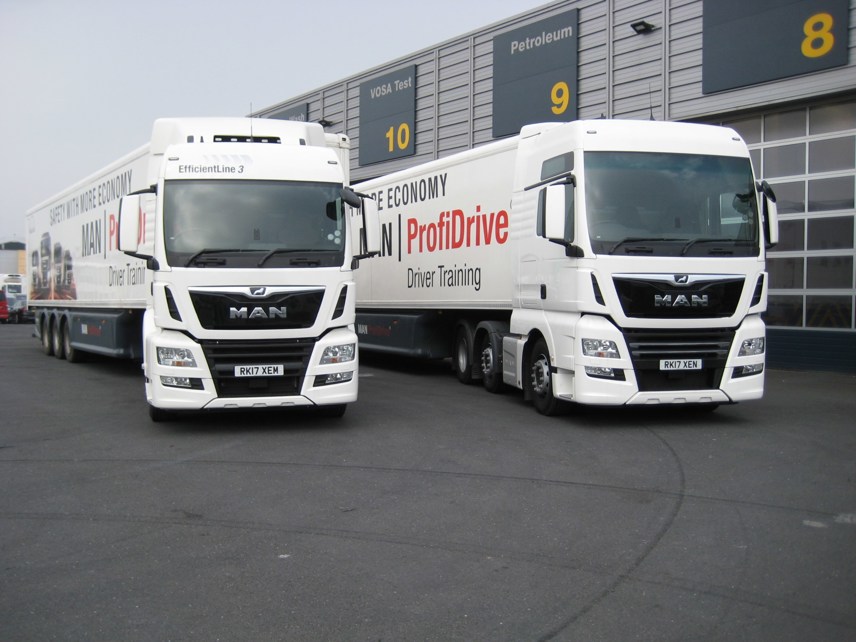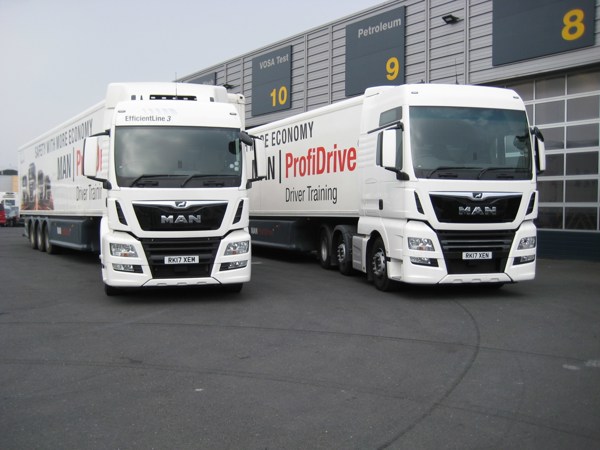Review
Away from our main focus on rigid trucks this issue we look at the MAN TGS, a smaller-cabbed tractor unit suitable for operators seeking a higher payload than the standard 10-20 tonnes of a rigid, but which can also operate within a semi-urban environment.
Our test model was the TGS 6x2 mid-lift tractor which we took out on the urban roads of Greater Manchester.
Following a recent update, the cab of the MAN TGS feels fresh and stylish, using a pleasant blend of beige and graphite panelling to give a bright and spacious impression. The low-sitting windscreen and side windows provide great all-round vision, a real bonus when driving around tight streets in cities and towns.
The multifunctional steering wheel is reach and rake adjustable and drivers can call up vehicle information, receive calls in safe situations and adjust the radio settings via the controls. The instrument panel has an LCD display, enabling the latest vehicle information to be viewed clearly, even in bright conditions.
MAN has introduced a new infotainment system, with a touchscreen display (standard five-inch, although there is an optional seven-inch display on the Media Truck Advanced), Bluetooth and auxiliary inputs and an optional sat-nav system. For ergonomic seating comfort there is a wide selection available, up to the air suspension and air conditioning of the driver’s seat.
The LX day cab sits above the L and M cabs, and is equipped with a bed, and there is the option for an upper bunk or a multifunction stowage facility. The generously proportioned stowage spaces and the standing room height in front of the co-driver’s seat (more than 1.9 metres) means the TGS has one of the most desirable cabs in the sector.
Our test vehicle had MAN’s 12.4-litre, six-cylinder D26 common rail engine, although there is the option of a smaller 10.5-litre D20. We tested the 426PS and 2,100Nm version. There are two higher outputs of 466PS/2,300Nm and 507PS/2,500Nm.
All TGS engines are coupled to 12-speed automatic TipMatic transmission as standard, but a 16-speed manual is also offered. EfficientLine models, like ours, come with a wide range of systems to reduce fuel consumption, such as optimised gear shifting, an aerodynamic pack, ‘energy’ tyres with pressure management, a cruise control system that monitors the topography of the route ahead to calculate the optimum time to accelerate and roll, a weight reduction pack and much more.
Like most Euro VI trucks, MAN uses selective catalytic reduction (SCR) but, because the exhaust gas recirculation system is so effective, the AdBlue consumption is one of the lowest in the sector. Intelligent ECU optimisation has also lowered the fuel consumption by 2.5% when compared with its predecessor.
As one may expect with the smaller cabbed tractor unit, the unladen weight of the TGS LX is competitive for a mid-lift coming in at around 8,275kg, complete with sleeper cab. As far as plated weights are concerned, the front axle has a standard capacity of eight tonnes, with the mid-lift axle at a maximum of 7.5 tonnes and the maximum drive axle plated weight of 11.5 tonnes.
The TGS sits on parabolic springs at the front, air on the mid-axle and a four bag ECAS-controlled system on the rear. All axles have hydraulic dampers with stabilisers on the front and rear. Keeping things very simple, the TGS is available with just one wheelbase at 2.6m which sounds a little short. However MAN measures this from the centre of the front axle to the centre of the mid. So add another 1.35m for the rear bogie spread and take the centre of this and we end up with a more ‘normal’ wheelbase of 3.275m.
MAN is well respected for its safety provisions and the TGS is no exception. A whole host of safety systems are fitted as standard on the vehicle, which helps reduce the chance or severity of accidents.
The ventilated discs are backed up by ABS, ESP (electronic stability control) and MAN Brakematic, which consists of an electronic brake system (EBS), including ABS and ASR, to reduce braking distances. The coupling force control for optimal balancing of the trailer and/or semitrailer brakes enables perfect brake performance, reduced braking distances and evens brake lining wear along the entire vehicle combination to increase the service life of the linings.
There is also adaptive cruise control, emergency stopping signal and active roll stabilisation. With active roll stabilisation, dampers are automatically regulated by the CDC (Continuous Damping Control) to prevent the development of rolling or pitching movements.
For vehicles with high centres of gravity, high-load roll stabilisation with an additional X control arm is ideal as this reduces sideways tilting.
As mentioned, the really clever system takes place in the EfficientLine when all these are linked to the intelligent cruise control called EfficientCruise and EfficientRoll helping to ‘look ahead’ for opportunities to reduce fuel consumption.
The TGS competes with the likes of the Volvo FM, a smaller tractor unit catering for a slightly more urban distribution-based operation although it has to be said the TGS cab sits high on the chassis, requiring a four-step entry.
Once in the cab, the driver is faced with a clean and bright environment with an instrument panel featuring two main dials for the speed and revs with four smaller ones for the water temperature, fuel and Adblue levels and air pressures.
In the centre is a digital panel for all the warning and check systems as well as an LCD display for the speed and Eco-based systems for the EfficientLine status. A colour seven-inch screen is just to the left of the main instrument panel which displays media and communication information.
Starting the 426PS engine produces just a very low hum in the cab, making you check the engine is on, and the auto system is simply a matter of turning the switch by the left hand side of the seat to ‘D’ for drive.
As we left the MAN dealer in Manchester, we were immediately met by a very congested narrow street requiring every inch of available road to be used (probably my poor driving) but the combination of a mid-lift axle and slightly smaller cab helped overcome this initial problem.
Once on the road in the Trafford Park area, the TGS settled down very quickly and, as with all new generation trucks, it became a matter of steering wheel ‘key punching’ rather than driving with your feet.
Once the adaptive cruise speed had been set, it nearly drives itself. MAN has integrated the latest technology, which is available on most other Euro VI-based competitors, under the heading of EfficientLine and the main benefits, to me, are twofold – greater safety by allowing the driver to concentrate on the road ahead (and to the side and back) and improved fuel economy.
There is no doubt the TGS delivers on both these features, encouraging very easy driving while delivering improved fuel economy, EfficientRoll predicts the road ahead and after taking in various inputs selects the most efficient engine revs including no revs at all. I think at one point we were doing 144mpg – but not for long.
The TGS is a bit of an unsung hero within the MAN heavy truck line-up, with its ‘bigger’ cousin, the TGA, taking most of the accolades. This is fine when you are spending four or five days away on the Continent. But, if you are operating in a mix of trunking and semi-urban environments and the truck comes ‘home’ nearly every night (with the occasional night out), then the TGS comes into its own.

















